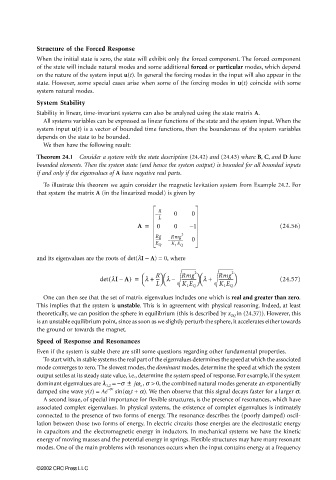Page 762 - The Mechatronics Handbook
P. 762
0066_Frame_C24 Page 10 Thursday, January 10, 2002 3:43 PM
Structure of the Forced Response
When the initial state is zero, the state will exhibit only the forced component. The forced component
of the state will include natural modes and some additional forced or particular modes, which depend
on the nature of the system input u(t). In general the forcing modes in the input will also appear in the
state. However, some special cases arise when some of the forcing modes in u(t) coincide with some
system natural modes.
System Stability
Stability in linear, time-invariant systems can also be analyzed using the state matrix A.
All systems variables can be expressed as linear functions of the state and the system input. When the
system input u(t) is a vector of bounded time functions, then the boundeness of the system variables
depends on the state to be bounded.
We then have the following result:
Theorem 24.1 Consider a system with the state description (24.42) and (24.43) where B, C, and D have
bounded elements. Then the system state (and hence the system output) is bounded for all bounded inputs
if and only if the eigenvalues of A have negative real parts.
To illustrate this theorem we again consider the magnetic levitation system from Example 24.2. For
that system the matrix A (in the linearized model) is given by
R
– --- 0 0
L
A = 0 0 – 1 (24.56)
Rg Rmg 2
------ – -------------- 0
E Q K E
1 Q
and its eigenvalues are the roots of det(λI − A) = 0, where
------------- l +
(
det lIA) = l + R Rmg 2 Rmg 2 (24.57)
–
-------------
--- l –
L
K 1 E Q
K 1 E Q
One can then see that the set of matrix eigenvalues includes one which is real and greater than zero.
This implies that the system is unstable. This is in agreement with physical reasoning. Indeed, at least
theoretically, we can position the sphere in equilibrium (this is described by x 2Q in (24.37)). However, this
is an unstable equilibrium point, since as soon as we slightly perturb the sphere, it accelerates either towards
the ground or towards the magnet.
Speed of Response and Resonances
Even if the system is stable there are still some questions regarding other fundamental properties.
To start with, in stable systems the real part of the eigenvalues determines the speed at which the associated
mode converges to zero. The slowest modes, the dominant modes, determine the speed at which the system
output settles at its steady state value, i.e., determine the system speed of response. For example, if the system
dominant eigenvalues are λ 1,2 = −σ ± jw o , σ > 0, the combined natural modes generate an exponentially
−st
damped sine wave y(t) = Ae sin(ω o t + α). We then observe that this signal decays faster for a larger σ.
A second issue, of special importance for flexible structures, is the presence of resonances, which have
associated complex eigenvalues. In physical systems, the existence of complex eigenvalues is intimately
connected to the presence of two forms of energy. The resonance describes the (poorly damped) oscil-
lation between those two forms of energy. In electric circuits those energies are the electrostatic energy
in capacitors and the electromagnetic energy in inductors. In mechanical systems we have the kinetic
energy of moving masses and the potential energy in springs. Flexible structures may have many resonant
modes. One of the main problems with resonances occurs when the input contains energy at a frequency
©2002 CRC Press LLC

